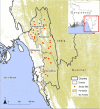Mapping the travel patterns of people with malaria in Bangladesh
- PMID: 32127002
- PMCID: PMC7055101
- DOI: 10.1186/s12916-020-1512-5
Mapping the travel patterns of people with malaria in Bangladesh
Abstract
Background: Spread of malaria and antimalarial resistance through human movement present major threats to current goals to eliminate the disease. Bordering the Greater Mekong Subregion, southeast Bangladesh is a potentially important route of spread to India and beyond, but information on travel patterns in this area are lacking.
Methods: Using a standardised short survey tool, 2090 patients with malaria were interviewed at 57 study sites in 2015-2016 about their demographics and travel patterns in the preceding 2 months.
Results: Most travel was in the south of the study region between Cox's Bazar district (coastal region) to forested areas in Bandarban (31% by days and 45% by nights), forming a source-sink route. Less than 1% of travel reported was between the north and south forested areas of the study area. Farmers (21%) and students (19%) were the top two occupations recorded, with 67 and 47% reporting travel to the forest respectively. Males aged 25-49 years accounted for 43% of cases visiting forests but only 24% of the study population. Children did not travel. Women, forest dwellers and farmers did not travel beyond union boundaries. Military personnel travelled the furthest especially to remote forested areas.
Conclusions: The approach demonstrated here provides a framework for identifying key traveller groups and their origins and destinations of travel in combination with knowledge of local epidemiology to inform malaria control and elimination efforts. Working with the NMEP, the findings were used to derive a set of policy recommendations to guide targeting of interventions for elimination.
Keywords: Bangladesh; Malaria epidemiology; Population movement.
Conflict of interest statement
The authors declare that they have no competing interests.
Figures






Similar articles
-
Malaria Surveillance - United States, 2017.MMWR Surveill Summ. 2021 Mar 19;70(2):1-35. doi: 10.15585/mmwr.ss7002a1. MMWR Surveill Summ. 2021. PMID: 33735166 Free PMC article.
-
Folic acid supplementation and malaria susceptibility and severity among people taking antifolate antimalarial drugs in endemic areas.Cochrane Database Syst Rev. 2022 Feb 1;2(2022):CD014217. doi: 10.1002/14651858.CD014217. Cochrane Database Syst Rev. 2022. PMID: 36321557 Free PMC article.
-
Malaria Surveillance - United States, 2015.MMWR Surveill Summ. 2018 May 4;67(7):1-28. doi: 10.15585/mmwr.ss6707a1. MMWR Surveill Summ. 2018. PMID: 29723168 Free PMC article.
-
Malaria Surveillance - United States, 2016.MMWR Surveill Summ. 2019 May 17;68(5):1-35. doi: 10.15585/mmwr.ss6805a1. MMWR Surveill Summ. 2019. PMID: 31099769
-
Forest malaria: the prevailing obstacle for malaria control and elimination in India.BMJ Glob Health. 2021 May;6(5):e005391. doi: 10.1136/bmjgh-2021-005391. BMJ Glob Health. 2021. PMID: 33990358 Free PMC article. Review.
Cited by
-
Impact of DDT on women's health in Bangladesh: escalating breast cancer risk and disturbing menstrual cycle.Front Public Health. 2024 Feb 12;12:1309499. doi: 10.3389/fpubh.2024.1309499. eCollection 2024. Front Public Health. 2024. PMID: 38410669 Free PMC article. No abstract available.
-
Human mobility and the infectious disease transmission: A systematic review.Geo Spat Inf Sci. 2024;27(6):1824-1851. doi: 10.1080/10095020.2023.2275619. Epub 2023 Nov 29. Geo Spat Inf Sci. 2024. PMID: 40046953 Free PMC article.
-
Malaria risk stratification in Lao PDR guides program planning in an elimination setting.Sci Rep. 2024 Jan 19;14(1):1709. doi: 10.1038/s41598-024-52115-2. Sci Rep. 2024. PMID: 38243065 Free PMC article.
-
Nonrepresentativeness of Human Mobility Data and its Impact on Modeling Dynamics of the COVID-19 Pandemic: Systematic Evaluation.JMIR Form Res. 2024 Jun 28;8:e55013. doi: 10.2196/55013. JMIR Form Res. 2024. PMID: 38941609 Free PMC article.
-
Bangladesh should engage the private sector for malaria elimination by 2030.Lancet Reg Health Southeast Asia. 2024 Sep 27;31:100487. doi: 10.1016/j.lansea.2024.100487. eCollection 2024 Dec. Lancet Reg Health Southeast Asia. 2024. PMID: 39399862 Free PMC article. Review.
References
-
- WHO . World Malaria Report. 2018.
-
- Murray CJ, Rosenfeld LC, Lim SS, Andrews KG, Foreman KJ, Haring D, et al. Global malaria mortality between 1980 and 2010: a systematic analysis. Lancet. 2012;379(9814):413–431. - PubMed
-
- Dondorp AM, Yeung S, White L, Nguon C, Day NP, Socheat D, et al. Artemisinin resistance: current status and scenarios for containment. Nat Rev Microbiol. 2010;8(4):272–280. - PubMed
Publication types
MeSH terms
Grants and funding
LinkOut - more resources
Full Text Sources
Medical

